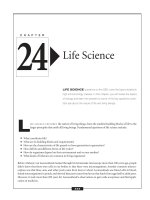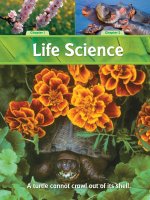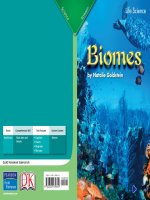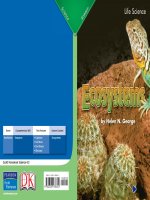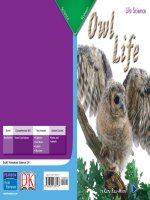biomes life science
Bạn đang xem bản rút gọn của tài liệu. Xem và tải ngay bản đầy đủ của tài liệu tại đây (5.03 MB, 10 trang )
by Natalie Goldstein
Scott Foresman Science 6.6
Genre Comprehension Skill Text Features Science Content
Nonfi ction Main Idea and
Details
• Captions
• Charts
• Diagrams
• Glossary
Biomes
ISBN 0-328-13985-8
ì<(sk$m)=bdjifj< +^-Ä-U-Ä-U
Life Science
13985_CVR_FSD Cover113985_CVR_FSD Cover1 05/27/05 9:39:37 AM05/27/05 9:39:37 AM
by Natalie Goldstein
Scott Foresman Science 6.6
Genre Comprehension Skill Text Features Science Content
Nonfi ction Main Idea and
Details
• Captions
• Charts
• Diagrams
• Glossary
Biomes
ISBN 0-328-13985-8
ì<(sk$m)=bdjifj< +^-Ä-U-Ä-U
Life Science
13985_CVR_FSD Cover113985_CVR_FSD Cover1 05/27/05 9:39:37 AM05/27/05 9:39:37 AM
Vocabulary
abiotic factor
biome
biotic factor
community
ecosystem
environment
population
What did you learn?
1. What makes up a population of organisms? What makes up
a community?
2. What is the difference between a biotic factor and an abiotic factor
in an ecosystem? Name one example of each.
3. In what way are the taiga biome and the tundra biome similar?
4.
The length of a biome’s growing season
has a huge effect on the number and variety of organisms living
there. Explain why a biome with a long growing season has more
organisms living in it than a biome with a short growing season.
5. Main Idea and Details Plants and animals are adapted
to survive in the biome in which they live. Choose one plant or
animal you read about and describe the adaptations it has that
help it survive in its environment.
Illustration: 8 Adam Benton
Photographs: Every effort has been made to secure permission and provide appropriate credit for
photographic material. The publisher deeply regrets any omission and pledges to correct errors called to its
attention in subsequent editions. Unless otherwise acknowledged, all photographs are the property of Scott
Foresman, a division of Pearson Education. Photo locators denoted as follows: Top (T), Center (C), Bottom
(B), Left (L), Right (R), Background (Bkgd).
Title Page: (CC) ©Joseph Van Os/Getty Images; 2 ©Ron Thomas/Getty Images; 3 ©DK Images; 5
©David Paynter/Age Fotostock; 6 ©Jose Fuste Raga/eStock Photo; 7 Jerry Young/©DK Images; 10 (TL)
©Michael Sewell/Peter Arnold, Inc., (BR) ©G.K. & Vikki Hart/Getty Images; 11 (T) ©Cornelia Doerr/Age
Fotostock, (B) ©Brian Sytnyk/Masterfile Corporation; 12 (CL) ©Paul A. Souders/Corbis, (B) ©Charlie
Ott Photography/Photo Researchers, Inc.; 13 (B) ©Tom Bean/DRK Photo, (CR) ©Frank Greenaway/DK
Images; 14 (B) ©Don Pitcher/Stock Boston, (CR) ©Joseph Van Os/Getty Images; 15 (B) ©Doug Sokell/
Visuals Unlimited, (CR) ©DK Images
ISBN: 0-328-13985-8
Copyright © Pearson Education, Inc.
All Rights Reserved. Printed in the United States of America. This publication is
protected by Copyright and permission should be obtained from the publisher prior
to any prohibited reproduction, storage in a retrieval system, or transmission in any
form by any means, electronic, mechanical, photocopying, recording, or likewise. For
information regarding permissions, write to: Permissions Department, Scott Foresman,
1900 East Lake Avenue, Glenview, Illinois 60025.
2 3 4 5 6 7 8 9 10 V010 13 12 11 10 09 08 07 06 05
13985_CVR_FSD Sec1:213985_CVR_FSD Sec1:2 05/27/05 9:39:55 AM05/27/05 9:39:55 AM
Biomes
by Natalie Goldstein
13985_01-16_FSD 113985_01-16_FSD 1 05/27/05 9:40:18 AM05/27/05 9:40:18 AM
How are organisms
on Earth connected?
Connections in the Biosphere
Living things are everywhere, from the highest mountains to the
bottom of the ocean. There is a large variety of living things on Earth,
from tiny insects to huge whales. The biosphere is the part of Earth
where living things are found. The biosphere extends from about
10 kilometers below the ocean’s surface to about 10 kilometers above
Earth’s surface.
Different living things may live in different parts of the biosphere,
but they all share Earth’s resources. So when something happens to
one living thing, it often affects other living things too. Humans are
part of the biosphere, so what humans do affects other living things.
All living things interact with other living things and with Earth.
Ecology is the study of how living things interact with each other and
their environment.
All living and
nonliving things
are part of this
biosphere.
2
13985_01-16_FSD 213985_01-16_FSD 2 05/27/05 9:40:23 AM05/27/05 9:40:23 AM
3
Organization of the Biosphere
You probably interact with many living things every day. Do you
have a pet? Did you walk your dog or pet your cat today? How many
people did you talk to today? It’s almost impossible to go through a
whole day without interacting with living things.
You also interact with the nonliving things around you. You
breathe air, drink water, and are warmed by sunshine. You could not
live without any of these things.
Living things, including humans, are called organisms. All the
organisms that live together in an area interact with each other. They
also interact with the nonliving things in their area. An organism’s
environment is anything that can affect the organism. The
environment includes living things and nonliving things.
13985_01-16_FSD 313985_01-16_FSD 3 05/27/05 9:40:41 AM05/27/05 9:40:41 AM
An individual is a single organism that belongs to one species.
A species is one type of living thing. A population is a group
of individuals that belong to the same species. A population of
organisms lives together in the same area. For example, look at the
zebras in the picture. All these zebras make up a population of zebras
that live together in the same place.
Other animals, such as giraffes and elephants, may live in
the same area as the zebras. Giraffes and elephants are different
species. There is a population of giraffes in this area. There is also a
population of elephants in this area. When scientists talk about a
particular population, they define the area in which it lives.
Individuals within a population compete for the resources in
the environment. For example, they compete for food and water.
If resources become limited, some individuals may die. Then the
population gets smaller.
4
13985_01-16_FSD 413985_01-16_FSD 4 05/27/05 9:40:54 AM05/27/05 9:40:54 AM
5
Single populations do not live alone. In any environment,
many populations live together and interact with each other. A
community is a group of populations that interact with each other
in a particular area. Zebras, giraffes, and elephants are all part of the
same community on an African plain.
If your family has pet dogs, cats, fish, or birds, several populations
live in your house. Your house contains a population of humans
and a population of each different species of pet. All these different
populations are part of the community that is your house.
Communities need the nonliving things in their environment to
live. They need air, water, and shelter, among other things. Together,
the living and nonliving parts of an environment are called an
ecosystem. An ecosystem is a community of organisms living
together along with the nonliving parts of the environment.
An ecosystem may be as small as a crack in a sidewalk or as large
as a huge forest or desert. Earth’s biosphere is made up of many
ecosystems. Every ecosystem interacts with other ecosystems.
13985_01-16_FSD 513985_01-16_FSD 5 05/27/05 9:41:06 AM05/27/05 9:41:06 AM
6
Meeting the Needs
of Organisms
All organisms in a community
depend on their environment to meet
their needs. Abiotic factors are
the nonliving parts of an ecosystem,
such as air, soil, water, sunlight, and
temperature. All living things need
water to survive. The amount of
water in an environment can limit
the number of organisms that can
live there. Few organisms are able to
survive in desert areas.
Plants need sunlight to make their
food in the process of photosynthesis.
Most organisms cannot make their
own food. They depend on plants.
Some animals eat plants directly;
others eat animals that eat plants. The
amount of sunlight an environment
gets also affects what kinds of plants
and animals that can live there.
An area’s temperature is another
factor that affects what types of
animals and plants can live there.
Each species can live only in a
particular range of temperature.
Polar bears live where it is very cold.
Cacti live in desert areas, where it is
very hot.
Most organisms need gases in air
to live. Land animals breathe oxygen
from the air. Organisms that live in
water get oxygen that has dissolved in
water. Plants need carbon dioxide to
make food through photosynthesis.
13985_01-16_FSD 613985_01-16_FSD 6 05/27/05 9:41:10 AM05/27/05 9:41:10 AM
7
Biotic factors are the living organisms in an ecosystem. Some
biotic factors are too tiny to see without a microscope. These include
bacteria that live in the soil and algae in the ocean. Mites and
protists that live in or on animals are also biotic factors.
Adaptations
An environment’s biotic and abiotic factors shape the communities
that live in an ecosystem. All organisms in an ecosystem have
adaptations that help them survive there. An adaptation is a
characteristic that helps an organism live and reproduce in a
particular environment. A polar bear has thick fur that keeps its body
warm. Its thick skin absorbs sunlight to warm its body. It has large
paws and claws to help it move over the ice and catch food. All these
characteristics are adaptations that help the polar bear survive in its
cold environment.
Polar bears
are adapted to
live in a cold
environment.
13985_01-16_FSD 713985_01-16_FSD 7 05/27/05 9:41:19 AM05/27/05 9:41:19 AM
8
What are Earth’s biomes?
Climate and Biomes
Different parts of Earth have similar communities. This occurs
when places have similar climates and landforms. A biome is a
large group of ecosystems with similar climates and organisms.
Scientists group ecosystems into biomes to help them describe the
world.
Climate is the average temperature and precipitation of an
area. Climate is very important in determining the characteristics
of a biome. For example, the growing season of plants is mainly
determined by temperature. Plants can only survive in a biome
if they are adapted to its yearly temperatures. Animals depend
on plants for food. So when plant populations get larger, animal
populations get larger as well.
A tropical rain forest is hot and gets lots of rain. Tropical rain
forests have many, many plants. They also have a large variety of
animals. Tropical rain forests are one of the richest biomes on Earth.
taiga
deciduous forest
13985_01-16_FSD 813985_01-16_FSD 8 05/27/05 9:41:21 AM05/27/05 9:41:21 AM
9
Characteristics of Biomes
Soil is another important factor in defining biomes. Different
types of soil occur in different places. The type of soil an area has
determines what plants can grow there. Some soils hold water near
the surface. These areas have plants with shallow roots. Plants with
deep roots could not survive in these soils.
As you read about different biomes, think about the type of soil
found in each. Think about how organisms are adapted to live in a
biome. Remember that a biome is not one particular place. A biome
is a group of similar ecosystems, which may occur in many places
on Earth.
tundra
desert
grassland
tropical rain forest
Deciduous
Forest
Taiga
Tundra
Tropical
Rain Forest
Desert
Grassland
13985_01-16_FSD 913985_01-16_FSD 9 6/2/05 4:50:52 PM6/2/05 4:50:52 PM
Tropical Rain Forest
Tropical rain forests contain more species
than any other biome. Tropical rain forests
once covered about 14 percent of Earth’s
land. Today more than half of these tropical
rain forests have been destroyed.
Dead organisms decay quickly in hot, wet
tropical rain forests. Plants quickly take up
their nutrients. In tropical rain forests, most
nutrients are found in plants. The soil is poor
in nutrients.
Trees grow very tall in tropical rain forests.
Their leafy tops form a dense covering called
the canopy. Little sunlight filters through this
covering. Though some shrubs grow beneath
the trees, few plants grow on the forest floor.
Most rain forest animals live in the treetops,
where they eat leaves and fruit.
Tree frogs such as
these are common
in tropical rain
forests.
10
13985_01-16_FSD 1013985_01-16_FSD 10 05/27/05 9:41:34 AM05/27/05 9:41:34 AM
11
Deciduous Forest
Deciduous forests grow where
summers are warm and winters
are cold. Deciduous trees shed their
leaves in autumn. They grow new
leaves each spring. Oak, maple, and
beech trees are common in deciduous
forests. Conifers, such as pine trees,
also grow here. Shrubs and ferns
grow on the forest floor.
Songbirds, deer, bears, and
porcupines are common animals in
deciduous forests. Because winters
are cold, some animal species hibernate to avoid the cold. Many
bird species migrate to warmer climates for the winter.
The leaves shed by deciduous trees decay on the forest floor. They
add nutrients to the forest soil. The soil beneath deciduous forests is
rich in nutrients.
Porcupine
13985_01-16_FSD 1113985_01-16_FSD 11 05/27/05 9:41:43 AM05/27/05 9:41:43 AM
Taiga
The taiga is a biome with long, cold, dark winters. Most trees that
grow in the taiga are conifers. These include fir and spruce trees. A
few deciduous trees and some shrubs also grow in this harsh, cold
biome.
Many taiga animals, such as squirrels and
birds, eat the seeds and berries of conifer trees.
Large animals, such as elk, deer, caribou, and
moose, eat tree bark and plant shoots. Wolves,
grizzly bears, and hawks hunt and eat the small
animals of the taiga.
The long, thick hair of this
caribou helps keep it warm
during long taiga winters.
12
13985_01-16_FSD 1213985_01-16_FSD 12 05/27/05 9:41:53 AM05/27/05 9:41:53 AM
Grassland
Grasslands get too little rain to support many large trees. Yet
grassland soil is very rich in nutrients. Many grasses in this biome
have deep roots. The roots add nutrients to the soil.
Grassland soil is excellent for farming. Every year millions of tons
of wheat, corn, and soybeans are grown on grasslands in the United
States.
Some of the largest animals on Earth live on grasslands. These
include bison, rhinoceros, and giraffes. Coyotes, as well as prairie
dogs and other rodents, are smaller animals of the grasslands.
Insects, such as grasshoppers, are common grassland animals too.
The grassland biome
provides plentiful food
for grasshoppers.
13
13985_01-16_FSD 1313985_01-16_FSD 13 05/27/05 9:42:01 AM05/27/05 9:42:01 AM
Tundra
The tundra has a very cold climate. Just beneath the surface, the
soil is frozen solid all year long. This frozen layer of soil is called
permafrost. Water cannot seep through permafrost, so when the
topsoil thaws in summer, it turns soggy. During the short summer,
mosquitoes and other insects hatch from surface pools. The insects
are food for many birds that fly to the tundra in summer to breed.
The tundra is so cold and windy that few plants grow there. Short
shrubs, moss, and very few short trees grow on the tundra. Animals
of the tundra include foxes, hares, many
types of birds and lemmings.
The dark feathers of this
ptarmigan turn white in
winter, which helps it hide
from predators in the snow.
14
13985_01-16_FSD 1413985_01-16_FSD 14 05/27/05 9:42:06 AM05/27/05 9:42:06 AM
Desert
The main feature of a desert is its lack of precipitation. Most deserts
are hot and dry. The driest hot deserts get almost no rainfall. But
some deserts can be very cool, especially at night.
Desert plants have adaptations, that help them to live with little
water. Cacti have short periods of growth. They have a waxy coating
that keeps them from losing water. Many desert animals are active
only at night, when it is cooler. Desert birds, snakes, turtles, and other
animals have adaptations that enable them to live on little water.
This Sonoran
kingsnake lives in
Utah, Arizona, New
Mexico, and Nevada.
15
13985_01-16_FSD 1513985_01-16_FSD 15 05/27/05 9:42:10 AM05/27/05 9:42:10 AM
16
Glossary
abiotic factor nonliving part of an ecosystem, such as water or
rocks
biome a large group of ecosystems with similar climates
and organisms
biotic factor living part of an ecosystem, such as a plant or
animal
community a group of populations that interact with each
other in a particular area
ecosystem a community of organisms living together along
with nonliving parts of the environment
environment anything that can affect an organism, including
living and nonliving things
population a group of individuals that belong to the same
species and live in the same area
13985_01-16_FSD 1613985_01-16_FSD 16 05/27/05 9:42:20 AM05/27/05 9:42:20 AM
Vocabulary
abiotic factor
biome
biotic factor
community
ecosystem
environment
population
What did you learn?
1. What makes up a population of organisms? What makes up
a community?
2. What is the difference between a biotic factor and an abiotic factor
in an ecosystem? Name one example of each.
3. In what way are the taiga biome and the tundra biome similar?
4.
The length of a biome’s growing season
has a huge effect on the number and variety of organisms living
there. Explain why a biome with a long growing season has more
organisms living in it than a biome with a short growing season.
5. Main Idea and Details Plants and animals are adapted
to survive in the biome in which they live. Choose one plant or
animal you read about and describe the adaptations it has that
help it survive in its environment.
Illustration: 8 Adam Benton
Photographs: Every effort has been made to secure permission and provide appropriate credit for
photographic material. The publisher deeply regrets any omission and pledges to correct errors called to its
attention in subsequent editions. Unless otherwise acknowledged, all photographs are the property of Scott
Foresman, a division of Pearson Education. Photo locators denoted as follows: Top (T), Center (C), Bottom
(B), Left (L), Right (R), Background (Bkgd).
Title Page: (CC) ©Joseph Van Os/Getty Images; 2 ©Ron Thomas/Getty Images; 3 ©DK Images; 5
©David Paynter/Age Fotostock; 6 ©Jose Fuste Raga/eStock Photo; 7 Jerry Young/©DK Images; 10 (TL)
©Michael Sewell/Peter Arnold, Inc., (BR) ©G.K. & Vikki Hart/Getty Images; 11 (T) ©Cornelia Doerr/Age
Fotostock, (B) ©Brian Sytnyk/Masterfile Corporation; 12 (CL) ©Paul A. Souders/Corbis, (B) ©Charlie
Ott Photography/Photo Researchers, Inc.; 13 (B) ©Tom Bean/DRK Photo, (CR) ©Frank Greenaway/DK
Images; 14 (B) ©Don Pitcher/Stock Boston, (CR) ©Joseph Van Os/Getty Images; 15 (B) ©Doug Sokell/
Visuals Unlimited, (CR) ©DK Images
ISBN: 0-328-13985-8
Copyright © Pearson Education, Inc.
All Rights Reserved. Printed in the United States of America. This publication is
protected by Copyright and permission should be obtained from the publisher prior
to any prohibited reproduction, storage in a retrieval system, or transmission in any
form by any means, electronic, mechanical, photocopying, recording, or likewise. For
information regarding permissions, write to: Permissions Department, Scott Foresman,
1900 East Lake Avenue, Glenview, Illinois 60025.
2 3 4 5 6 7 8 9 10 V010 13 12 11 10 09 08 07 06 05
13985_CVR_FSD Sec1:213985_CVR_FSD Sec1:2 05/27/05 9:39:55 AM05/27/05 9:39:55 AM
